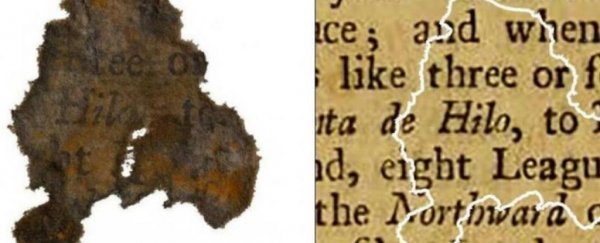A rare discovery from Queen Anne's Revenge - the wreck of famous pirate Blackbeard's ship - could offer some insight into the sort of reading material you might find on a pirate vessel.
Scraps of decaying paper were found waterlogged and stuffed in a cannon. It's a remarkable find, since paper extremely rarely survives shipwrecks - never mind a shipwreck from 300 years ago.
The 16 small fragments, after careful analysis, turned out to be the account of the adventures of a sea captain, which sounds like a fitting read for a sailor.
Queen Anne's Revenge had only been in the pirate's possession six months when he ran her aground in May 1718, off the North Carolina coast. He abandoned her to the sea, and she remained lost until 1996.
Since that time, the Queen Anne's Revenge Project has been excavating the shipwreck, piece by painstaking piece.
The team has recovered and carefully cleaned tens of thousands of artefacts, including weaponry, mundane everyday items such as bowls and pots and spoons, ship equipment and medical tools, and personal items such as cufflinks, belt buckles, and pipes.
Paper, however, breaks down and disintegrates really quickly in the ocean, so if the crew had any books or diaries aboard, they were long since lost.
Except these 16 tiny scraps. They managed to survive being washed away by being stuffed into the chamber of a breech-cannon.
So sodden and discoloured was the mass that the conservators, when they first found it while cleaning the cannon in 2016, thought it was cloth, stuffed into the chamber as a gasket for the wooden tampion that protected the inside of the cannon's barrel from the elements.
The scraps were extremely delicate. As they were working to preserve them, the team figured out that some - just 7 of the 16 - had a few legible words of text printed on them. They also noticed that the text was running in the same direction, suggesting that the fragments were all torn from the same book.
They made out the words "fathom" and "south", but it was one word in particular that led to the book's identification: Hilo.
"It was very distinctive and italicised, which might indicate a place name," conservator Kimberly Kenyon told National Geographic.
It turned out not to be the town of Hilo, Hawaii, which didn't appear in print until 1778, but the Spanish settlement of Ilo on the Peruvian coast - described by a seaman named Edward Cooke in a genre of ocean-faring memoir called a voyage narrative.
In A voyage to the South Sea, and round the world, perform'd in the years 1708, 1709, 1710, and 1711, first published in 1712, Cooke describes his adventures aboard two ships, Duke and Dutchess, under Captain Woodes Rogers.
Cooke and Rogers both wrote about the voyage, describing the rescue of Alexander Selkirk from the Juan Fernández Islands - an incident that inspired Robert Louis Stevenson's Robinson Crusoe.
As for how the book got aboard Queen Anne's Revenge, who it belonged to, and why it ended up in the cannon - those questions are probably likely to remain a mystery.
However, it's an important piece of archaeological evidence for the presence of books on sailing vessels in the 18th century - and although historical record does refer to the presence of books among Blackbeard's crew, none of the titles were known.
The scraps of paper are undergoing conservation, and will appear at a special exhibition commemorating the 300th anniversary of Blackbeard's death later this year.
